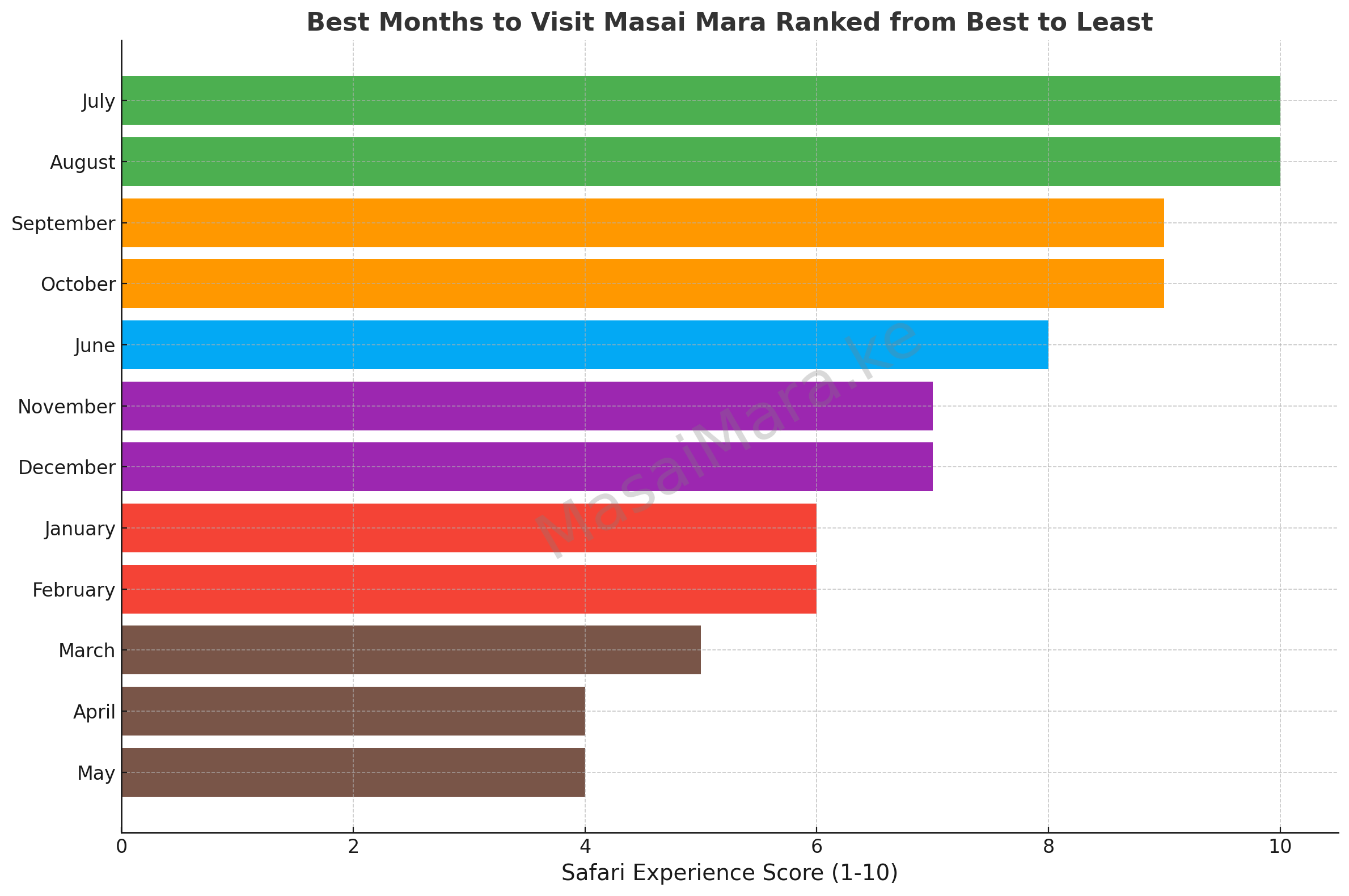Yes, April can be a surprisingly rewarding month for a Masai Mara safari, especially for travelers seeking solitude, lush landscapes, and budget-friendly adventures. According to MasaiMara.ke’s Safari Experience Score, April earns a 4 out of 10, placing it alongside May as one of the less conventional safari months. However, this score doesn’t fully capture the unique charm of April safaris.

While it’s true that April falls within Kenya’s long rainy season, making road conditions challenging and wildlife slightly dispersed, it also offers incredible opportunities for photographers, bird watchers, and budget-conscious travelers. Dramatic skies, vibrant greenery, abundant wildlife without crowds, and deeply discounted safari rates make April a hidden gem for those who know what to expect.
1. April Weather in Masai Mara: A Green Paradise with Rainy Challenges
April is the peak of the long rainy season in Masai Mara, meaning frequent showers, often heavy, but typically interspersed with clear skies and bursts of sunshine.
- Rainfall: Expect afternoon and evening thunderstorms, while mornings are often dry and cool, perfect for game drives. The rain transforms the Mara into a lush, emerald-green paradise.
- Temperature: Daytime highs average 22°C to 26°C (72°F to 79°F), while early mornings and evenings can dip to 10°C to 14°C (50°F to 57°F).
- Humidity: Higher than in the dry season, but the cooler temperatures offset any discomfort.
While the rain can make some roads muddy and difficult to navigate, it’s part of the adventure. 4×4 safari vehicles are essential, and experienced guides know how to maneuver through the slick terrain, sometimes leading to unexpected, off-the-beaten-path wildlife encounters.
2. Wildlife in April: Still Thriving, Just Spread Out
Despite the rains, Masai Mara’s resident wildlife is abundant and active in April. Unlike the Great Migration months, where herds are densely packed, April offers a more natural, undisturbed safari experience.
- Big Cats: Lions, leopards, and cheetahs are still easy to spot. The cooler weather keeps them active throughout the day, and the green backdrop makes them stand out.
- Resident Game: Elephants, giraffes, zebras, buffaloes, and hippos are abundant year-round. While water sources are plentiful, animals still frequent open plains, especially during dry spells between rains.
- Birdwatching Paradise: April is prime birdwatching season. Migratory species are still present, and many resident birds are in their brightest breeding plumage, creating spectacular photo opportunities.
Although the Great Migration isn’t in Masai Mara during April, the lack of tourist vehicles means you’ll have intimate, uninterrupted wildlife sightings, something rare during the busy migration months.
Forum Insight: “We visited in April and loved the exclusivity. Yes, it rained, but we had entire lion sightings to ourselves, and the green scenery was stunning for photography.”
3. Budget-Friendly Safari: April’s Hidden Advantage
One of April’s biggest draws is its affordability. As part of the low season, safari prices drop significantly.
- Park Entry Fees:
- Non-residents: $100 per day (compared to $200 from July to December).
- Kenyan citizens: KES 1,500 per day (versus KES 3,000 in peak season).
- Accommodation Discounts: Many lodges and camps offer deep discounts, with some luxury properties offering rates up to 50% lower than during the peak season. This means you can stay in high-end safari camps at budget-friendly prices.
- Exclusive Safaris: With fewer tourists, you’ll enjoy private game drives, personalized service, and peaceful moments in nature without the hustle of peak-season crowds.
Traveler Review: “April felt like we had Masai Mara to ourselves. We stayed in a luxury camp at half the usual price, and the sightings were just as good, if not better, because there was no one else around.”
4. Pros and Cons of Visiting Masai Mara in April
✅ Pros:
- Affordable Safaris: Low park fees and deeply discounted accommodation rates.
- Uncrowded Parks: Enjoy private wildlife sightings with few other vehicles around.
- Lush Green Scenery: Vibrant landscapes perfect for photography.
- Active Predators: Big cats remain active in cooler weather conditions.
- Birdwatching Heaven: Excellent for bird enthusiasts with migratory and breeding species.
⚠️ Cons:
- Unpredictable Weather: Frequent rains, though usually in the afternoons and evenings.
- Muddy Roads: Some areas become inaccessible without a reliable 4×4 vehicle.
- No Great Migration: The famous river crossings occur later in the year.
5. How April Compares to Other Months
- Versus March (5/10): March offers slightly better road conditions as it’s the start of the long rains. However, April’s scenery is more vibrant, and accommodations are often cheaper.
- Versus May (4/10): May continues the rainy season, but April tends to have less saturated landscapes and slightly more predictable weather patterns.
- Versus June (8/10): June is part of the dry season with better game viewing and accessibility but comes with higher prices and more tourists.
- Versus July (10/10): July is the peak season, featuring the Great Migration and ideal weather. However, it’s also twice as expensive, and sightings often involve crowded vehicles.
Final Verdict: Is April Worth It?
Absolutely—if you know what to expect. April is not for those seeking the postcard-perfect dry season safari. But for adventurous travelers, photographers, bird watchers, and budget-conscious explorers, April offers a unique, raw safari experience that’s hard to find during busier months. The combination of affordable rates, minimal crowds, lush scenery, and abundant wildlife makes it a hidden gem for those willing to embrace the green season’s unpredictability. If you’re flexible, don’t mind occasional rain, and crave a quieter, more intimate safari, April in Masai Mara can be truly magical.
